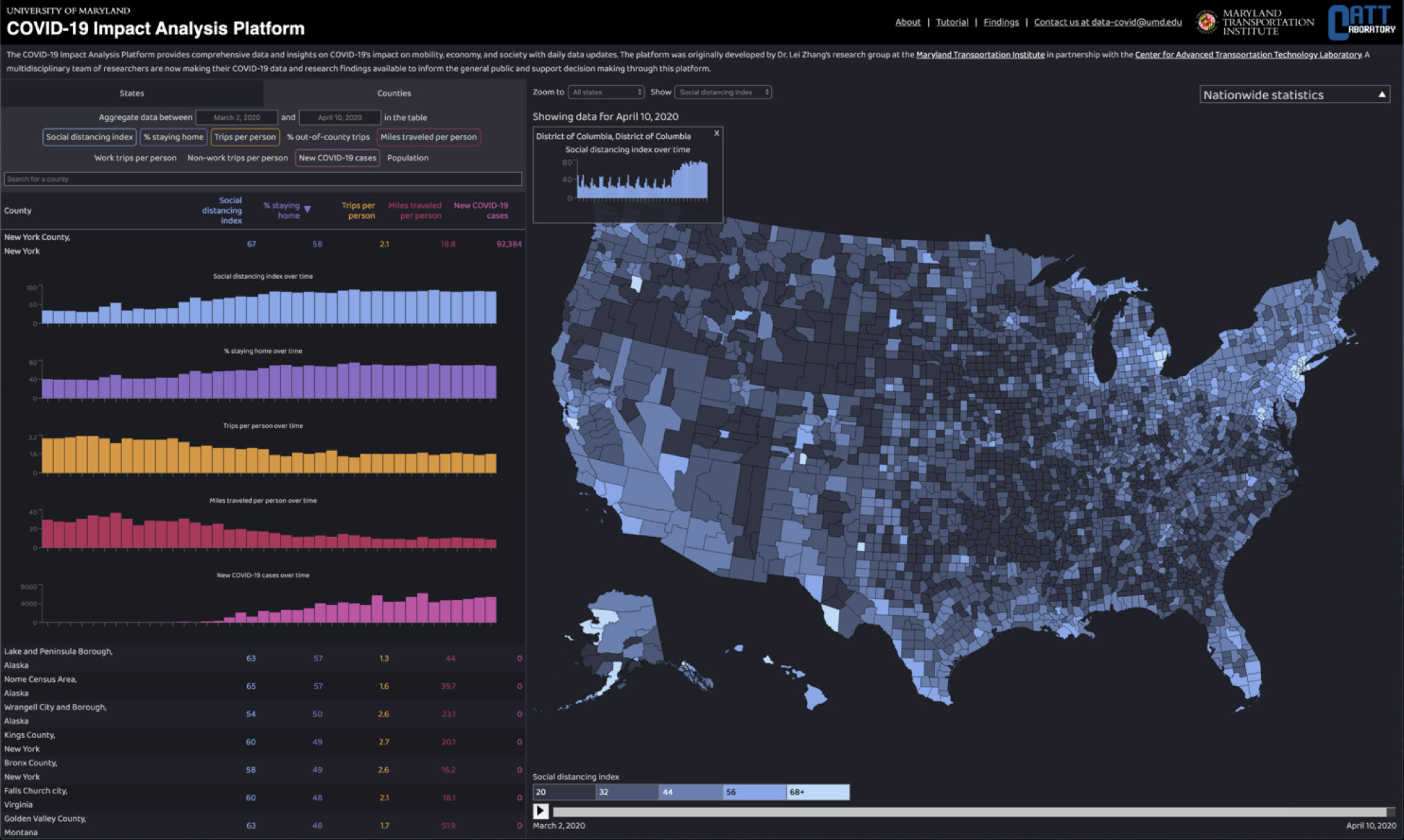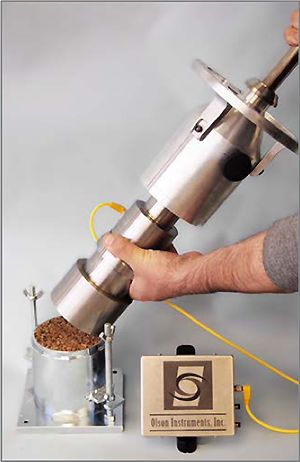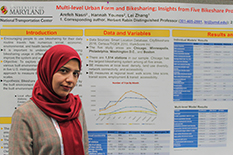News Story
Data-Driven Research, Pandemic Impact Highlighted at TRB
 With transportation researchers from across the United States and the globe assembling this month—virtually—for the Transportation Research Board’s (TRB) annual meeting, transportation engineers, data scientists and other experts from the University of Maryland’s A. James Clark School of Engineering have been presenting a rich array of innovative projects, tools, and technologies.
With transportation researchers from across the United States and the globe assembling this month—virtually—for the Transportation Research Board’s (TRB) annual meeting, transportation engineers, data scientists and other experts from the University of Maryland’s A. James Clark School of Engineering have been presenting a rich array of innovative projects, tools, and technologies.
The Clark School is home to a widely utilized COVID-19 Impact Analysis Platform, which leverages mobile device data to track travel behavior and other COVID-related metrics, and several papers presented at TRB have presented findings drawn from this platform. Maryland Transportation Institute (MTI) Co-Director Lei Zhang, who led development of this resource, presented an overview of its capabilities.
Demonstrating the platform’s research applications, MTI Assistant Director Chenfeng Xiong and members of his research group presented studies on the analysis and modeling of mobility trends during the pandemic, the phenomenon of “quarantine fatigue” and its effects on social distancing, compliance with stay-at-home orders, the pandemic’s effect on use of different travel modes, and the impact of pandemic-related policies on outcomes in urban areas.
“While the pandemic has been a devastating even both here in the United States and globally, it is important not to pass up the opportunity to glean valuable data from it—data that can be used to help us better prepare for crises that may arise in the future,” Xiong said. “The UMD COVID-19 Impact Analysis Platform is a wellspring for such essential data.”
CATT Laboratory Virtual Booth
Besides the COVID-19 dashboard, many other UMD projects are being highlighted at the TRB meeting. UMD’s Center for Advanced Transportation Technology Laboratory, which maintains the Regional Integrated Transportation Information System (RITIS), is running a virtual booth that showcases some of the capabilities being developed at the Lab.
These include an intersection analytics module that uses probe vehicle data trip data to enable users to analyze the performance of potentially thousands of intersections; a suite of tools that tracks the impact of emergencies and major events across multiple transportation modes (land, sea, and air), and a tool for tracking energy consumption and emissions across the nation’s highways.
During a lightning talk session on data visualization, CATT Lab assistant director Gregory Jordan and lead transportation analyst Mark Franz demonstrated how vehicle probe data, weather radar, and navigation software such as Waze can be used to track and analyze traffic congestion more precisely.
“The principles developed in this project will allow transportation analysts to better understand the underlying causes of congestion on roadways,” Franz said. “The results of this analysis will enable data-driven decision support for the allocation of limited congestion mitigation resources.”
A paper presented by Mofeng Yang, a Maryland Transportation Institute PhD student, also focused on leveraging real-time data—in this case, for the purpose of measuring and comparing the usage of different travel modes.
“This research proposed and validated a methodology framework to estimate travel mode shares at county/state/nation level with large-scale mobile device location data. The proposed framework can be readily applied in different states and metropolitan regions with low cost in order to study multimodal travel demand, understand and prioritize multimodal travel needs, and support decision making,” Yang said.
 Improving Quality Assurance in Road Construction
Improving Quality Assurance in Road Construction
Research presented at the TRB meeting has focused not only on transportation and mobility, but also on topics related to the engineering and construction of the nation’s roadways. Charles W. Schwartz, chair of the UMD civil and environmental engineering department and an internationally recognized authority on pavement design and analysis, presented results from a study on the use of Lightweight Deflectometers (LWD) to test soil compaction—an important part of the quality assurance process.
Schwartz is helping to pioneer procedures that employ LWDs to measure stiffness, as opposed to density. Unlike the traditional, density-based methods, the new approach does not utilize radiation and thus presents fewer storage and regulatory issues. It can also be implemented more quickly and at a lower cost. However, a number of challenges remain, including differences in the configurations of various LWDs, the need to establish reliable stiffness targets, and the variability induced by factors such as moisture. Schwartz’s TRB presentation detailed the work done to address these problems.
“The procedures and draft specifications we developed are on their way to being adopted as formal standards in many states,” Schwartz said. “This is an example of engineering research making a tangible impact on practice.”
The lists below summarize UMD contributions to the TRB annual meeting.
Committees and Subcommittees
Data for Operations Subcommittee, Nikola Ivanov presiding
Young Member Coordinating Council, Nikola Ivanov, presiding
Papers and Presentations
“A Big-Data Driven Approach to Analyzing and Modeling Human Mobility Trend under Non-Pharmaceutical Interventions during COVID-19 Pandemic,” Songhua Hu, Chenfeng Xiong, Mofeng Yang,Hannah Younes, Weiyu Luo, Lei Zhang
“A Data-Driven Travel Mode Share Estimation Framework based on Mobile Device Location Data,” Mofeng Yang, Yixuan Pan, Aref Darzi, Sepehr Ghader, Chenfeng Xiong, Lei Zhang
“An Arterial-Friendly Local Ramp Metering Control Strategy,” Yao Cheng, Gang-Len Chang
“An Interactive Covid-19 Mobility Impact and Social Distancing Analysis Platform,” Lei Zhang, Sepehr Ghader, Michael Pack, Aref Darzi, Chenfeng Xiong, Mofeng Yang, Qianqian Sun, Aliakbar Kabiri, Songhua Hu
“A Deep Learning Model for Off-ramp Hourly Flow Estimation,” Amir Nohekhan, Sara Zahedian, Ali Haghani
“Adoption of Non-Destructive Testing in Mix Design and Quality Assurance of Hot Mix Asphalts,” Anjuman Ara Akhter, Dimitrios Goulias
“A Novel Methodology for Integrated Problem of Stowage Planning with Crane Split in Container Terminals, Yimei Chang, Ali Haghani, Masoud Hamedi
“Constructing Evacuation Evolution Patterns and Decisions Using Mobile Device Location Data: A Case Study of Hurricane Irma,” Aref Darzi, Vanessa Frias-Martinez, Sepehr Ghader, Hannah Younes, Lei Zhang
“Detection of High-risk Segments of Traffic Incidents on Freeway Networks by Multi-Kernel Density Estimation and Spatial Analysis,” Binya Zhang
“Estimating Traffic Volume with Limited Observations: A Combination of Sampling Expansion and Geographically Weighted Poisson Regression,” Yi Jing, Songhua Hu, Hangfei Lin
“Evaluation of Acceptance Risks through PWL for Highway Materials and Pavement Construction,” Yunpeng Zhao, Dimitrios Goulias
“Generalized Conflation Method for Linking Road Network Segmentations: Application to OpenStreetMap and Traffic Message Channel Basemaps,” Zachary Vander Laan, Kaveh Sadabadi
“High-Resolution Cumulative Exposure Assessment of Traffic-Related Air Pollution with Different Google Navigation Route Options,” Minmeng Tang, Deb Niemeier
“How Different Age Groups Responded to the COVID-19 Pandemic in Terms of Mobility Behaviors: Case Study of the United States,” Aliakbar Kabiri, Aref Darzi, Weiyi Zhou,
Qianqian Sun, Lei Zhang
“How Social Distancing, Mobility, and Preventive Policies Affect COVID-19 Outcomes in Urban Areas: Big Data-driven Evidence from the DMV Megaregion,” Jina Mahmoudi, Chenfeng Xiong, Lei Zhang
“Impacts and Adaptations to DOT Count Programs of COVID-19,” Michael Pack
“Implementation Sequence Optimization for Dedicated Bus Lane Projects,” Murat Bayrak,
S. Ilgin Guler, Paul Schonfeld
“Investigating the Impact of Tolling System on I-66 Inside the Capital Beltway,” Sara Zahedian,
Amir Nohekhan, Kaveh Sadabadi
“Joint Analysis of Scooter Sharing and Bikesharing Usage: A Structural Equation Modeling Approach,” Yi Jing, Songhua Hu, Hangfei Lin
Lectern Session: Incorporation of NDT Methods in the Quality Assurance of Concrete During Production and Construction, Dimitrios Goulias, presiding
“Mid-America Regional Council Pilot,” Thomas Jacobs
“Modeling Indoor-level Non-pharmaceutical Interventions During the COVID-19 Pandemic: A Pedestrian Dynamics-based Microscopic Simulation Approach, Yao Xiao, Mofeng Yang, Zheng Zhu, Hai Yang, Lei Zhang, Sepehr Ghader
“Mobile Device Location Data Reveals Human Mobility Response to Stay-at-Home Orders during the COVID-19 Pandemic in the U.S.,” Chenfeng Xiong, Songhua Hu, Mofeng Yang, Hannah Younes, Weiyu Luo, Sepehr Ghader, Lei Zhang
“Non-Destructive Testing for Strength Gain Monitoring of Concrete in Quality Assurance,” Setare G Saremi, Dimitrios Goulias
“Observed Mobility Behavior Data Reveal “Social Distancing Inertia,” Sepehr Ghader, Jun Zhao, Minha Lee, Weiyi Zhou, Guangchen Zhao, Lei Zhang
“Optimization of Farm Product Logistics: A Case Study in Central Appalachia,” Youngmin Choi, Jason Wang, Paul Schonfeld
“Optimized Restoration Sequence for Disrupted Freight Rail Network,” Fei Wu, Paul Schonfeld, Myungseob Kim
Panel Discussion: Concept and Application of using Geosynthetics for Base Reinforcement,” David White, John Siekmeier, Charles W. Schwartz, Imad Al-Qadi
“Pay Factor Analysis for Highway Pavements through PWL and Monte Carlo Simulation,” Yunpeng Zhao, Dimitrios Goulias
“Perceived Trip Time Reliability and its Cost on a Rail Transit Network,” Jie Liu, Paul Schonfeld, Jinqu Chen, Yong Yin, Qiyuan Peng
“Public-Private Partnership and Social Equity: An Empirical Study of the DBE Program,” Kunqi Zhang, Qingbin Cui
“Quantifying Human Mobility Behavior Changes during the COVID-19 Outbreak in the United States,”
Yixuan Pan, Aref Darzi, Aliakbar Kabiri, Guangchen Zhao, Weiyu Luo, Chenfeng Xiong, Lei Zhang
“Quarantine Fatigue: First-ever decrease in social distancing measures after the COVID-19 pandemic outbreak before reopening United States,” Jun Zhao, Minha Lee, Sepehr Ghader, Hannah Younes, Aref Darzi, Chenfeng Xiong, Lei Zhang
“Review of Length Approximations for Tours with Few Stops,” Youngmin Choi, Paul Schonfeld
“Stiffness-Based Compaction Quality Assurance Testing Using Lightweight Deflectometers,” Charles W. Schwartz
Published January 28, 2021










